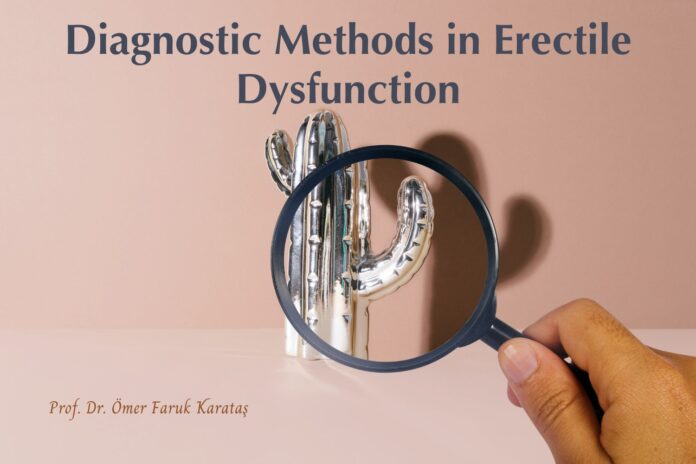From painful intercourse to sexual reluctance, from erectile dysfunction to fear and anxiety, sexual dysfunctions are issues that should be evaluated comprehensively.
Erectile dysfunction, which is one of the most common sexual dysfunctions, is generally defined as the inability to achieve an erection sufficient for sexual activity in the penis or its termination without satisfaction even if achieved. Up to 50% of men over the age of 40 may experience erectile dysfunction.
What is erectile dysfunction?
Men can become ready for sexual intercourse very soon after being sexually aroused. In this process, blood coming from the arteries collects in the veins of the penis and hardening occurs.
Erectile dysfunction is defined as the inability to achieve or maintain an adequate erection for sexual intercourse. Having occasional erectile dysfunction is not a cause for concern. In addition, if the erection problem is experienced constantly and negatively affects sexual life, it can cause stress, self-confidence and relationship problems.
Erectile dysfunction in men can also be a sign of an underlying health condition that requires treatment, such as heart health or diabetes.
When should you see a doctor?
If you have a long-term erection problem, it is important to consult a specialist urologist. However, if you are worried about erection, or if you are experiencing other sexual problems such as premature or late ejaculation, it is useful to consult a doctor.
If you have diabetes, heart disease, or any known health condition that may be associated with erectile dysfunction, you should be examined immediately.

How is erectile dysfunction diagnosed?
In order to diagnose erectile dysfunction, a number of issues need to be thoroughly investigated in patients:
- Medical History and Details of Sexual Life:
It is very important to take a detailed medical history from the patient for erectile dysfunction. In this way, clues about the physical and psychological health of the person are learned. In addition, questions about the details of the sexual life of the patient and his partner are also asked. Here, all factors such as the duration of sexual intercourse, its continuity, morning and evening erections are important to confirm the diagnosis.
- Physical Examination:
This may include careful examination of the penis and testicles and checking the nerves for sensation. In addition, a neurological examination can be performed to fully understand the erection problem.
- Psychosocial Evaluation:
At this stage, information about the patient’s motivation to have sexual intercourse, his relationship with his partner, the techniques he uses in sexual intercourse and how his performance is during the relationship is obtained. However, the patient may be asked various questions to assess depression, anxiety, or other psychological conditions.
- Laboratory Tests:
A blood sample may be sent to the laboratory to check for heart disease, diabetes, low testosterone levels, and other health conditions. Like blood tests, urine tests are used to look for signs of diabetes and other underlying health conditions.
- Ultrasound and Color Doppler:
With the ultrasound device held on the blood vessels feeding the penis, it can be seen whether the patient has blood flow problems. Medication may also be injected into the penis to better assess blood flow in ultrasound tests. In addition, the blood flow in the blood vessels in the penis is analyzed with the color doppler test.
- Biothesiometry:
This test uses electromagnetic vibration to test nerve function that produces an erection as a result of stimulation.
- NPT (Nocturnal Penile Tumescence) Test:
In this test, a special device placed around the penis determines whether the patient has an erection during sleep.

Who gets erectile dysfunction?
Erectile dysfunction, which usually occurs due to age, is more common in men over the age of 40. In addition, men who have a chronic disease, have high blood pressure or cholesterol complaints, have a sedentary lifestyle, use certain medications that may cause this problem, and are over a certain weight may also have erectile dysfunction.
Diseases causing erectile dysfunction
Many of the erectile dysfunctions have underlying medical and psychological causes. Some of these are important diseases such as:
- Diseases such as diabetes, kidney failure, cirrhosis, high cholesterol,
- Some neurological diseases such as epilepsy, stroke, MS,
- Cardiovascular diseases such as atherosclerosis, peripheral vascular diseases, previous heart attack, hypertension,
- Lung diseases such as COPD and sleep apnea,
- Urological diseases such as Peyronie’s disease,
- Psychological problems and psychiatric diseases such as depression, post-traumatic stress disorder, sexual performance anxiety,
- Thyroid diseases and endocrinological diseases related to sex hormones,
- Some chemotherapy or radiotherapy processes that can be used in the treatment of some cancers.
Psychological dimension of erectile dysfunction
The mechanism that provides the erection starts in the brain, which is triggered by feelings of sexual excitement. For this reason, some situations can affect sexual excitement and cause erection problems.
Depression, anxiety or other mental health conditions are the main psychological factors that cause this condition. So much so that a stressful life, relationship problems with the partner, and the anxiety and stress that develops due to these can directly cause erection problems.
Can the erection problem be prevented?
The best way to prevent erectile dysfunction is to adopt a healthy lifestyle and solve existing health problems without wasting time. For this, it is necessary not to interrupt the doctor’s checks in order to manage diabetes, heart disease or other chronic health conditions.
It is especially important to quit smoking, limit or quit alcohol completely, and stay away from drugs. Exercising regularly will help both reduce stress levels and maintain overall body health. Also, getting help with anxiety, depression or other mental health problems can prevent erectile dysfunction. Of course, eating a healthy and regular diet will also benefit sexually.
What is the best treatment for erectile dysfunction?
Erectile dysfunction, which can be seen in many men and can become a serious problem, can be treated with various methods. Treatment of erectile dysfunction varies according to the underlying problem.
If there is a problem such as diabetes or heart disease, referral is made for the treatment of these diseases first. In this process, some medications may be recommended for erectile dysfunction. In addition, topical treatment methods can also be applied.
In the vacuum device method, which is another option, the penis is fully grasped with cylindrical devices. The vacuum feature of the device helps the penis to reach the desired hardness. This method is mostly preferred if the treatments mentioned in the first stage are invalid. Another alternative is penile injection therapy.
In this process, the drug is injected into the spongy tissues inside the penis. Surgical applications are recommended for patients who cannot benefit from all these. At this stage, penile prosthesis application is performed.
When is penile prosthesis necessary in treatment?
If all treatment methods fail to produce results, penile prosthesis implantation is in question. In this operation, one of the two prostheses is placed inside the penis.
One of these prostheses is a semi-rigid prosthesis, while the other is an inflatable prosthesis. Semi-rigid prostheses in the form of two bendable rods are placed in the chambers of the penis that enable erection.
The inflatable prosthesis, which stands out as another type of prosthesis, is a device that contains liquid and is placed inside the penis. This device for drawing fluid is also placed in the scrotum in some cases. Inflatable prosthesis stands out as the most preferred type of prosthesis.




